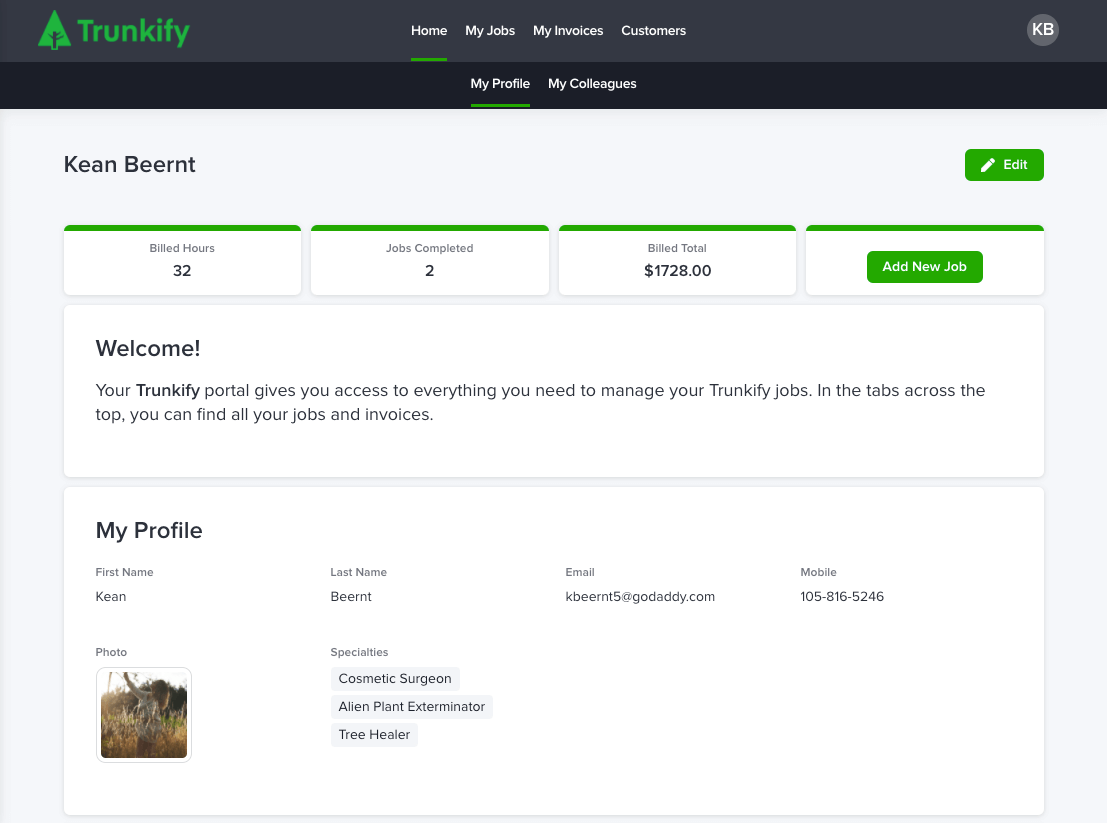At Bubble, we want to enable potential builders to create their ideas without code, so we are exploring and reviewing the many tools and software that entrepreneurs might use to build their ideas.
What is Stacker?
Stacker is a no-code web app builder that generates customizable applications based on user data from systems like Airtable, Google Sheets, and Salesforce. Rather than sifting through tabs and scrolling through data in their Airtable, Stacker users are given an app that can act as an internal tool for different teams or as an external-facing app for clients and employees.
Using data from tools like Airtable or Google Sheets, users can create customizable CRM’s. After users sign up they are prompted to create their app name, link the corresponding data, and can make decisions on what elements of the data set are highlighted in the initial version of the app. With the CRM you can more easily manage business processes that have traditionally required manual work, including customer needs, contact information, support tickets and meetings. With Stacker teams are afforded an additional layer of communication, allowing for real-time collaboration on projects and tasks. Overall, Stacker’s CRM capabilities streamline the account management experience for teams at mid-size and large businesses.

Stacker also offers its users the ability to create customer account portals, where users can give their customers access specific details and updates about their projects or orders. For example, let’s say a company that offers product development for entrepreneurs uses Stacker to facilitate their customer experience. Because of Stacker, this product development company can offer entrepreneurs access to an intuitive platform, where they can change details about their specific product and communicate with a support team if need be.
Users can employ similar features with client project portals, which allows Stacker users to give external clients increased visibility into things like projects, status updates, future work, invoices and support requests. The client portals are effective at improving communication for external stakeholders, a useful tool for fast-paced startups or companies that have projects in rapid development.
The platform also offers options for mobile workforce management, where clients can simplify and centralize certain processes like invoicing, schedules, and tasks. Users can allow their mobile workers to get a clear view of the amount of hours they’ve logged, the amount of money they’ve made, and any changes to their team.

Who is Stacker for?
Stacker primarily serves product and account management teams at medium to large companies. The platform helps these teams eliminate the need to source app development from outside developers, and allows teams to iterate on app designs as the company changes. Stacker also works well for startups and smaller businesses that may not have full product or account teams in place. Founders and senior leadership that are shouldering the bulk of the work at newer, small businesses can take advantage of the platform's simplified communications and data management.
Freelance consultants and strategists could also make use of the platform’s client portals when it comes to secure data-sharing and account service.
Stacker Cost and Pricing
(Pricing model evaluation: August 2020)
Stacker is free to build for as long as you’d like. The platform doesn’t have a trial expiration for any apps the teams may be building, but you’ll need to subscribe to Stacker to actually launch your app for your customers.
When you do want to subscribe, there are four options: Starter, Plus, Pro, and Team. One thing to note for startups: there are qualifying conditions that startups must meet before you’re granted access to the Starter plan. The plan is only available to early-stage companies that are under 18 months old, have less than five employees, and have under $250K in funding. Additionally, users should note that Stacker is priced per app, not per user. All plans come with a base number of 500 users, with additional users available upon request. Additional details on each plan include:
Starter plan: $49/month if paying monthly or $39/month if paying annually
- 10,000 records
- One view per table
- Simple permissions
- Stacker branding
Plus plan: $149/month if paying monthly or $125/month if paying annually
- No record limit
- Multiple views per table
- Simple permissions
- Subtle branding
- Email support
Pro plan: $349/month if paying monthly or $290/month if paying annually
- No record limit
- Multiple views per table
- Permissions by user role
- Whitelabel
- Custom Domain
- Priority support
Team plan: $799/month if paying monthly or $649/month if paying annually
- Unlimited apps
- Enterprise SLAs
- Enterprise Support
- All benefits included in Pro plan
Stacker vs. Bubble: A Comparison
How does Stacker compare to a no-code platform like Bubble?
The main similarities between Bubble and Stacker include:
Both Bubble and Stacker offer web-browser based no-code app building functionality.
Both Bubble & Stacker offer privacy rules to manage which data users are allowed to see.
Both Bubble and Stacker allow users to see every action users take on the app with real-time logging.
Both Bubble and Stacker offer integration with popular analytics tools.
The main differences between Bubble and Stacker are:
Built-in vs. External Database: Stacker is great for established businesses with existing datasets but requires new entrepreneurs to build their datasets in Google Sheets or Airtable before turning them into a Stacker app. Bubble comes with a fully built-in database where you can customize your data types and do not need an external application. That said, you can also import data from a CSV file into your Bubble database. And Bubble now allows you to integrate with an existing Airtable database.
App-building Capabilities: Stacker is meant to streamline workflows and processes, but doesn’t offer much more than assistance with account and client services. . Bubble allows you to fully build an app of any type, with if-then logic and a drag-and-drop Workflow tool. Established businesses that need an app can utilize Bubble as well, but Bubble’s platform offers entrepreneurs of all experience levels the tools they need to get their business off the ground.
Free Tier Functionality: While Stacker lets you build your web-app for free, users can’t launch their apps without choosing a subscription plan. At the lowest-paid tier, users still have to include Stacker branding, and the requirement isn’t phased out unless you’re using the Pro plan or higher. At Bubble’s free tier, users enjoy all of the core features of the platform, allowing them to create any number of free apps, in exchange for Bubble branding and hosting on a bubbleapps.io domain. Upgrading to any paid Bubble plan for your apps allows you to host on a custom domain when your app is finished, but you can build almost everything out for free.
Alternatives to Stacker
Alternative web-app builders include the following tools:
- If you’re looking for a cheaper alternative that works specifically with Google Sheets, check out Glide.
- For teams that are looking to streamline workflows for engineers, try out Internal.
- For a comprehensive no-code platform that has it's own database, use Bubble.
- If you’re looking for a powerful internal app builder, check out Retool.
- For startups that are focused on product-market fit, try out Y-Code.
About Bubble
Bubble is a leader in the no-code movement. Bubble offers a powerful point-and click web editor and cloud hosting platform that allows users to build fully customizable web applications and workflows, ranging from simple prototypes to complex marketplaces, SaaS products, and more. Over 400,000 users are currently building and launching businesses on Bubble - some have gone on to participate in top accelerator programs, such as Y Combinator, and even raised $365M in venture funding. Bubble is more than just a product. We are a strong community of builders and entrepreneurs that are united by the belief that everyone should be able to create technology.
Disclaimer: The goal of these reviews is to provide an honest, practical, differentiated comparison of features and educate readers on tools in the no-code ecosystem so that you can evaluate how these services fit together and serve your needs.
Build your app on Bubble's Free plan. No need to upgrade until you're ready to launch your app.
Join Bubble





